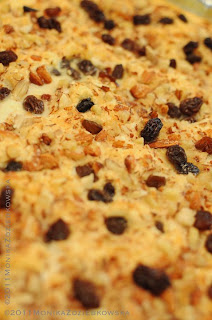The Indonesian rijsttafel, a Dutch word that literally translates to "rice table", is an elaborate meal adapted by the Dutch from the Indonesian feast called nasi padang. It consists of many (forty is not an unusual number) side dishes served in small portions, accompanied by rice prepared in several different ways. Popular side dishes include egg rolls, sambals, satay, fish, fruit, vegetables, pickles, and nuts. In most areas where it is served, such as Indonesia, the Netherlands, and other areas of heavy Dutch influence (such as parts of the West Indies), it is known under its Dutch name.
The Dutch colonial feast, the rijsttafel, was created to provide a festive and official type of banquet that would represent the multi-ethnic nature of the Indonesian archipelago. Dishes were assembled from many of the far flung regions of Indonesia, where many different cuisines exist, often determined by the religion of the particular island or island group - vegetarian cuisine from the predominantly Hindu island of Bali, halal cuisine from the Sumatra region, and many others from the hundreds of inhabited islands, which know more than 300 regional and ethnic language groups. Brought back to the Netherlands by former colonials and exiled Indonesians after Indonesia gained its independence in 1945, the rijsttafel was predominantly popular with Dutch families with colonial roots. In the past two decades, however, Indonesian food has become part of a mainstream interest in South East Asian cuisine, and there has been a proliferation of Indonesian restaurants in the Netherlands.
More of a banquet than a meal, the rijsttafel has survived Indonesia's independence, composed as it is of indigenous Indonesian dishes, and is served in many mainstream restaurants in Indonesia. A typical rijsttafel will have several dining tables covered with different dishes, while in some fancy settings in Indonesia each dish may be served by a separate waitress.
Rijsttafels strive to feature an array of not only flavors and colors and degrees of spiciness but also textures, an aspect that isn't commonly discussed in western food. Such textures may include crispy, chewy, slippery, soft, hard, velvety, gelatinous, and runny.
A list of typical dishes in the rijsttafel
The following is a brief, but not nearly complete list of examples of foods that may be found on a rijsttafel:
Daging Semur – Stir-fried beef with sauce
Gado-gado - Vegetables (cooked or fresh) with peanut sauce (sambal kacang)
Krupuk – Shrimp crackers
Lumpia – Egg rolls
Nasi goreng – Fried rice
Nasi kuning - Indonesian yellow rice
Perkedel - Meat and potato patties
Pisang Goreng - Banana fritters
Sambal Iris – Onion, tomato and chilli pasta
Sambal Kacang - Peanut sauce
Sambal Ulek – Spicy chilli paste
Sate - Various thinly sliced meats, marinated then broiled on a skewer, such as: Sate Ayam, chicken; Babi, Sate Lembu, Beef
Serundeng - Peanuts with coconut
Tahu Telur - Tofu omelet
Telur Balado - Hard-boiled eggs sautéed in chilli sauce
Sayur Lodeh - Vegetable stew (spicy) in coconut milk
Daging Rendang - Aromatic beef braised in coconut milk
Opor Ayam - Chicken coconut curry







